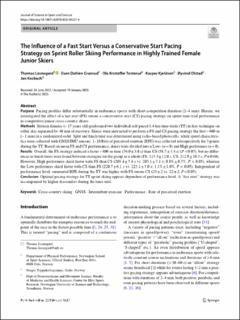| dc.contributor.author | Losnegard, Thomas Johansen | |
| dc.contributor.author | Granrud, Even Dahlen | |
| dc.contributor.author | Tosterud, Ola Kristoffer | |
| dc.contributor.author | Kjeldsen, Kasper | |
| dc.contributor.author | Olstad, Øyvind | |
| dc.contributor.author | Kocbach, Jan Martin | |
| dc.date.accessioned | 2023-05-05T12:23:42Z | |
| dc.date.available | 2023-05-05T12:23:42Z | |
| dc.date.created | 2023-03-08T08:59:50Z | |
| dc.date.issued | 2023 | |
| dc.identifier.citation | Journal of Science in Sport and Exercise. 2023, Artikkel 00221-4. | en_US |
| dc.identifier.issn | 2096-6709 | |
| dc.identifier.uri | https://hdl.handle.net/11250/3066477 | |
| dc.description | This article is licensed under a Creative Commons Attribution 4.0 International License, which permits use, sharing, adaptation, distribution and reproduction in any medium or format, as long as you give appropriate credit to the original author(s) and the source, provide a link to the Creative Commons licence, and indicate if changes were made. The images or other third party material in this article are included in the article's Creative Commons licence, unless indicated otherwise in a credit line to the material. If material is not included in the article's Creative Commons licence and your intended use is not permitted by statutory regulation or exceeds the permitted use, you will need to obtain permission directly from the copyright holder. | en_US |
| dc.description.abstract | Purpose: Pacing profiles differ substantially in endurance sports with short competition duration (2–4 min). Herein, we investigated the effect of a fast start (FS) versus a conservative start (CS) pacing strategy on sprint time-trial performance in competitive junior cross-country skiers.
Methods: Sixteen females (~ 17 years old) performed two individual self-paced 1.4 km time-trials (TT) in free technique on roller skis separated by 40 min of recovery. Skiers were instructed to perform a FS and CS pacing strategy the first ~ 400-m (~ 1 min) in a randomized order. Split and finish time was determined using radio-based photocells, while speed characteristics were collected with GNSS/IMU sensors. 1–10 Rate of perceived exertion (RPE) was collected retrospectively for 3 points during the TT. Based on mean FS and CS performance, skiers were divided into a Low- (n = 8) and High performers (n = 8).
Results: Overall, the FS strategy induced a faster ~ 400-m time (56.0 ± 3.8 s) than CS (58.7 ± 3.4 s) (P < 0.05), but no differences in finish times were found between strategies for the group as a whole (FS: 213.3 ± 12.0 s; CS, 212.9 ± 10.3 s, P = 0.68). However, High performers skied faster with FS than CS (203.4 ± 7.4 s vs. 205.1 ± 7.1 s; 0.8% ± 0.7%, P < 0.05), whereas the Low performers skied faster with CS than FS (220.7 ± 6.1 s vs. 223.1 ± 5.0 s; 1.1% ± 1.0%, P < 0.05). Independent of performance level, summated RPE during the TT was higher with FS versus CS (23 ± 2 vs. 22 ± 2, P < 0.05).
Conclusion: Optimal pacing strategy for TT sprint skiing appears dependent of performance level. A “fast start” strategy was accompanied by higher discomfort during the time-trial. | en_US |
| dc.language.iso | eng | en_US |
| dc.subject | cross-country skiing | en_US |
| dc.subject | GNSS | en_US |
| dc.subject | intermittent exercise | en_US |
| dc.subject | performance | en_US |
| dc.subject | rate of perceived exertion | en_US |
| dc.title | The influence of a fast start versus a conservative start pacing strategy on sprint roller skiing performance in highly trained female junior skiers | en_US |
| dc.type | Peer reviewed | en_US |
| dc.type | Journal article | en_US |
| dc.description.version | publishedVersion | en_US |
| dc.rights.holder | © The Author(s) 2023 | en_US |
| dc.source.pagenumber | 9 | en_US |
| dc.source.journal | Journal of Science in Sport and Exercise | en_US |
| dc.identifier.doi | 10.1007/s42978-023-00221-4 | |
| dc.identifier.cristin | 2132180 | |
| dc.description.localcode | Institutt for fysisk prestasjonsevne / Department of Physical Performance | en_US |
| dc.source.articlenumber | 00221-4 | en_US |
| cristin.ispublished | true | |
| cristin.fulltext | original | |
| cristin.fulltext | original | |
| cristin.qualitycode | 1 | |
